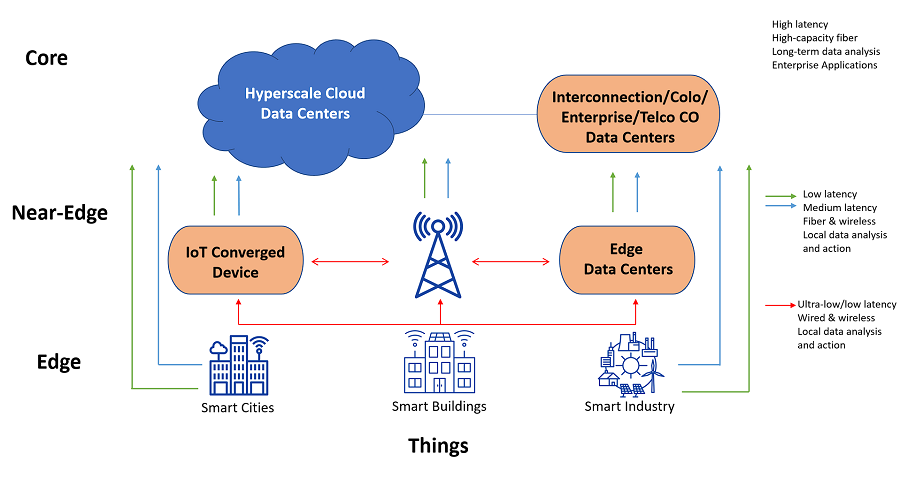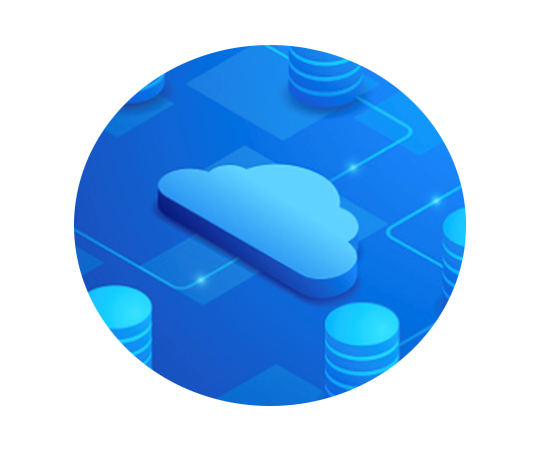Hyperscale Essentials. Speed, Scale, Performance
Hyperscale facilities are the largest data centers in the world. The typical footprint of these facilities are at least 10,000 square feet and house more than 5,000 servers that run on ultra-high-speed, high-fiber networks. The hyperscale market’s massive capital requirements dictate that there are only a handful of hyperscale data center operators, namely Amazon, Facebook, Google, IBM, Microsoft, and Oracle. In addition, there are the wholesale colocation and data center development companies that cater to them, like Equinix and Digital Realty.
The architecture of a hyperscale data center allows it to scale appropriately in response to increasing demand for resources. The ability to seamlessly build and add compute, memory, networking, and storage resources is critical when the associated demand is requested. Features and functionality are being released and rapidly added therefore it is important to prioritize interoperability, availability, and reliability.
Hyperscale requirements include the ability to rapidly scale infrastructure, support demanding workloads, reliable network connectivity, high levels of security, and cost-effective infrastructure.

Hyperscale Data Centers. The Network Ecosystem Core
The core of a hyperscale network ecosystem is designed to provide fast, reliable, and scalable connectivity between different parts of the infrastructure, enabling hyperscale data centers to handle large volumes of data and support demanding workloads such as big data analytics and artificial intelligence/machine learning.

Total OOB™ Management for Hyperscale Data Centers
Hyperscale data centers often have thousands or even tens of thousands of devices and systems; including servers, switches, routers, storage arrays, and other equipment. Managing and monitoring this vast assortment of hardware is a complex task, and any downtime can have a significant impact on operations and user experience. These data centers are critical for providing services and supporting applications that are essential to businesses, organizations, and individuals.
Total OOB™ management is a way to manage and monitor devices and systems in a data center using a separate, dedicated network connection. This means that even if the main network connection fails or is unavailable, administrators can still remotely manage and troubleshoot the equipment using the out-of-band connection.
Total OOB™ management solution ensures that administrators can quickly and easily diagnose and resolve issues, even if the primary network connection is unavailable. This can help reduce downtime, improve system availability, and ultimately ensure that critical applications and services remain online and accessible to users. Additionally, it provides an added layer of security, as administrators can remotely access and manage equipment without needing to be physically present in the data center.
Hyperscale Data Centers Demand Network Resilience
A hyperscale data center can have tens of thousands of devices in data centers around the world therefore visibility and access to your network infrastructure is critical for the business. An outage at a hyperscale data center can result in a $100M loss in 8 hours, consequently network teams will build a management network separate from the production network, to access and remediate problems quickly and securely from wherever they are located.
Total OOB™ management provides a complete out-of-band management solution, essential for hyperscale providers to monitor, alert and maintain connectivity and business operations when the network goes down. It ensures that they have secure remote access, cellular failover, automation and a cloud-based management portal, all key components of network resilience and keeping a competitive edge.
Operational Resilience is Vital
Managing the business side of a hyperscale data center can be just as complex as managing thousands of devices. Operational Resilience is the ability to deliver network operations and core business lines through a disruption from any hazard. Gearlinx™ ZERO provides a holistic view that enables a hyperscale network team to manage both network infrastructure and operational elements such as serial numbers, warranty, and subscription status.
Gearlinx™ helps to remove the complexity of managing administrative overhead by simplifying operational resilience and letting you take control of managing your network and business.
Don’t Wait, Automate
A classic use case for hyperscale providers is to leverage Zero Touch Provisioning (ZTP) to provision routers and switches and decrease the amount of time spent doing repetitive tasks and eliminating human error. Other popular automation tools used by a hyperscale data center provider include Ansible, Puppet, Chef, Docker, APIs, and Python. A hyperscale data center team can leverage automation to reduce costs and save time for deployments, improve staff efficiencies, minimize configuration errors, and accelerate go to market time.
Hyperscale data centers often rely on automation and containers to manage and orchestrate the thousands of devices and systems that make up the infrastructure. Automation tools and systems can help streamline operations, reduce errors, and improve efficiency. However, automation also brings new challenges. For example, if an automated process fails or encounters an issue, it can be challenging to diagnose and resolve the problem quickly. This is where Total OOB™ management comes into play.
By using Total OOB™ management, administrators can remotely access and manage equipment and systems even if the main network connection is down or unavailable. This means that if an automated process encounters an issue, administrators can quickly diagnose and resolve the problem using the out-of-band management connection.
Additionally, out-of-band management can help support automation by providing a reliable and secure way to manage equipment and systems during upgrades, maintenance, and other tasks. For example, if an automated upgrade process encounters an issue, administrators can use Total OOB™ to remotely access and manage the equipment to resolve the problem without needing to be physically present in the data center. Total OOB™ is an essential tool for hyperscale data centers that rely on automation to manage their complex infrastructures. It provides an added layer of reliability, security, and flexibility that ensures critical applications and services remain online and accessible to users.

Software for Open Networking in the Cloud (SONiC)
A new development in the past ten years is the ability for companies to run a guest operating system on a network device. Microsoft Azure founded SONiC in 2016 through the Open Compute Project (OCP) to bring high reliability, flexibility and fast innovation to the routers and switches in Azure cloud data centers. It was designed to meet the demanding requirements of a cloud data center, and many high-profile technology companies contribute to SONiC including Alibaba, Arista Networks, Broadcom, Dell, Cisco, Comcast, Google, Intel, Juniper, Microsoft, Nvidia, and VMWare.
Hyperscale data centers use the SONiC operating system because it provides a scalable, flexible, and open-source platform for managing network devices. One of the key benefits of SONiC is its ability to run on a wide variety of network hardware from different vendors, allowing data center operators to avoid vendor lock-in and choose the hardware that best fits their needs. SONiC also provides a modular architecture that makes it easy to add or remove features and applications as needed, allowing data center operators to customize their network infrastructure to meet their specific requirements.
Another benefit of SONiC is its support for a variety of network protocols, including BGP, OSPF, and VXLAN. This enables data center operators to build highly scalable and reliable networks that can support large numbers of virtual machines and containers. In addition to these benefits, SONiC is also highly secure, with built-in support for secure boot, device encryption, and other security features. This is critical for hyperscale data centers that need to protect their infrastructure from cyber threats and other security risks.
The Gearlinx™ NR4400 was designed to address massive scale and out-of-band management control over your compute platforms in the data center. The network team can build or deploy containers and/or download virtual machines (like SONiC) onto the NR4400 to empower the edge or their data center, all while staying in control and managing their network. The modular architecture makes it easy to add or remove features and applications as needed, allowing you to customize your network infrastructure to meet your specific requirements.
NR4400 Network Resilience Platform
The NR4400 is the perfect network resilience platform for hyperscale data centers. It has the performance, speed, and scale to grow and expand with the demanding requirements of a hyperscale data center. The NR4400 Network Resilience as a Service™ consumption model allows you to save 40% in upfront hardware costs and a subscription for as little as $1/day, putting the network team in control so they can tame operational costs. The NR4400 is an enterprise Total OOB™ management and compute platform designed and optimized for ensuring business continuity in high density, mission-critical, hyperscale data centers.
It is an ideal platform to deploy, manage, and remediate hyperscale network infrastructure. To learn more about the capabilities, visit the NR4400 product page.
ZERO Cloud-Based Centralized Management
ZERO is the Operational Resilience as a Service™ (ORAAS) platform for the NR4400. It provides a centralized view of your Total OOB™ network and 3rd party devices. ZERO’s API-First strategy allows for tight integration so a hyperscale data center can leverage existing DevOps and NetOps tools used within their environment.
The ZERO ORAAS™ platform enables scale for infrastructure deployments by providing a single point of control for managing and monitoring your Gearlinx™ infrastructure and the routers, switches, firewalls, attached to the NR4400. ZERO gives the hyperscale network team immediate reach and command of critical network infrastructure along with the information they need to make operational improvements and life cycle management.
To learn more about the capabilities, visit the ZERO product page.
